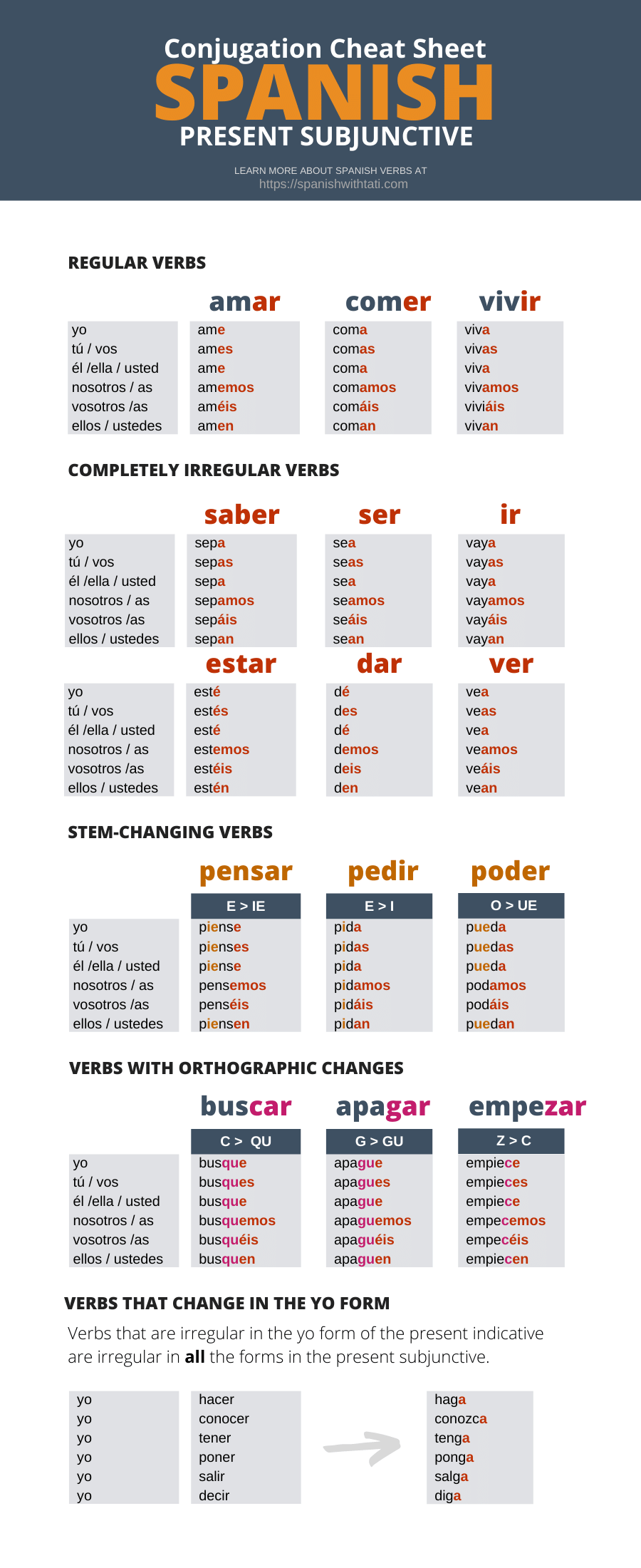Table of Contents
Present Subjunctive Endings

The present subjunctive endings of verbs that end in -ar are:
• e
• es
• e
• emos
• éis
• en
For -er and -ir verbs, use:
• a
• as
• a
• amos
• áis
• an
Regular Verbs
Can you conjugate Spanish verbs in the simple present tense? If so, conjugating verbs in the present subjunctive will be easy for you!
Learn how to use regular verbs with the post How to Conjugate Regular Verbs in Spanish (+ Free PDF).
You can form the present subjunctive of almost all verbs from the yo form of the present indicative. You just need to drop the -o and add the proper ending to the stem. Let me give you some examples.
What’s the conjugation of amar (to love) in the simple present tense for the yo form? You are right. It’s amo (I love). Since the verb amar ends in -ar, it is necessary to use the present subjunctive endings of verbs that end in -ar to conjugate this verb.
Let’s conjugate this verb together! First, we need to get rid of the -o in amo. We are left with am. Now, let’s add the endings -e, -es, -e, -emos, -éis, -en to it to get the present subjunctive conjugation of amar.
| pronouns | simple present | present subjunctive |
| yo | amo | ame |
| tú / vos | ames | |
| él / ella / usted | ame | |
| nosotros / as | amemos | |
| vosotros / as | améis | |
| ellos / ustedes | amen |
Stem-Changing Verbs
You can conjugate stem-changing verbs using the steps you followed above. However, there is something important that you need to remember about these verbs.
Stem-changing verbs are called “boot” verbs. Have you ever wondered why? It’s because when they are conjugated and placed in a conjugation table, the only verbs that suffer a stem change form a boot.
| quiero | queremos |
| quieres | queréis |
| quiere | quieren |
That kind of looks like a boot, doesn’t it?
Notice that the nosotros and vosotros forms in the chart are not affected by the stem change in the simple present tense. Well, those forms are not affected in the present subjunctive either.
Alright, let’s conjugate the lovely verb querer (to want, love). What’s the conjugation of querer in the simple present tense for the yo form? You are right again. It’s quiero (I want).
Let’s get rid of the -o in quiero. We are left with quier. Since querer ends in -er, it is necessary to use the present subjunctive endings for verbs that end in -er to conjugate this verb.
| pronouns | simple present | present subjunctive |
| yo | quiero | quiera |
| tú / vos | quieras | |
| él / ella / usted | quiera | |
| nosotros / as | queramos | |
| vosotros / as | queráis | |
| ellos / ustedes | quieran |
Verbs With Orthographic Changes
A few regular and irregular verbs suffer orthographic changes when they are conjugated in the present subjunctive tense.
The most common spelling changes are the following.
• Verbs that end in -gar change g to gu.
• Verbs that end in -car change c to qu.
• Verbs that end in -zar change z to c.
A common verb that ends in -zar is comenzar. It is a stem-changing verb.
Do you know the yo form of comenzar in the simple present tense? It’s comienzo. Let’s follow the steps we have learned to conjugate this verb!
If we get rid of the -o in comienzo, we are left with comienz. Now, remember that verbs that end in -zar change z to c, so we have comienc.
Let’s use the present subjunctive endings for verbs that end in -ar to conjugate this verb: -e, -es, -e, -emos, -éis, -en.
| pronouns | simple present | present subjunctive |
| yo | comienzo | comience |
| tú / vos | comiences | |
| él / ella / usted | comience | |
| nosotros / as | comencemos | |
| vosotros / as | comencéis | |
| ellos / ustedes | comiencen |
Completely Irregular Verbs
There are only seven verbs that are completely irregular in the present subjunctive tense. I would suggest you learn the conjugation of the following verbs by heart.
For a full list of irregular verbs in Spanish, visit the post 200 Examples of Spanish Irregular Verbs.
Notice that the conjugation of ser and ver in the present subjunctive is very similar.
| pronouns | SER | VER |
| yo | sea | vea |
| tú / vos | seas | veas |
| él / ella / usted | sea | vea |
| nosotros / as | seamos | veamos |
| vosotros / as | seáis | veáis |
| ellos / ustedes | sean | vean |
The verbs ir and haber also have similar conjugation patterns in the present subjunctive.
| pronouns | IR | HABER |
| yo | vaya | haya |
| tú / vos | vayas | hayas |
| él / ella / usted | vaya | haya |
| nosotros / as | vayamos | hayamos |
| vosotros / as | vayáis | hayáis |
| ellos / ustedes | vayan | hayan |
Estar and dar share similarities in their conjugation pattern as well.
| pronouns | ESTAR | DAR |
| yo | esté | dé |
| tú / vos | estés | des |
| él / ella / usted | esté | dé |
| nosotros / as | estemos | demos |
| vosotros / as | estéis | deis |
| ellos / ustedes | estén | den |
Finally, notice the present-subjunctive conjugation of saber.
| pronouns | SABER |
| yo | sepa |
| tú / vos | sepas |
| él / ella / usted | sepa |
| nosotros / as | sepamos |
| vosotros / as | sepáis |
| ellos / ustedes | sepan |
Verbs That Are Irregular In the Yo Form Only
Verbs that irregular in the yo form of the present indicative are irregular in all the forms in the present subjunctive.
Notice the conjugation of hacer, a verb that is irregular in the yo form only in the present indicative.
Can you recall the conjugation of hacer for the yo pronoun in the present indicative? It’s hago.
Get rid of the -o in hago and add the proper endings to conjugate this verb.
| pronouns | simple present | present subjunctive |
| yo | hago | haga |
| tú / vos | haces / hacés | hagas |
| él / ella / usted | hace | haga |
| nosotros / as | hacemos | hagamos |
| vosotros / as | hacéis | hagáis |
| ellos / ustedes | hacen | hagan |
Conjugate the following verbs the same way we conjugated hacer.
Get rid of the -o ending of the yo form of the present indicative tense of the following verbs. Then, add -a, -as, -a, -amos, -áis, -an to what you are left with to conjugate them in the present subjunctive tense.
| pronouns | present indicative | present subjunctive |
| yo | conozco | conozca |
| yo | tengo | tenga |
| yo | pongo | ponga |
| yo | salgo | salga |
| yo | vengo | venga |
| yo | digo | diga |
| yo | oigo | oiga |
| yo | pido | pida |
Present Subjunctive Ending Chart
I hope this sheet helps you remember what we learned today!

Think this is neat? Share it with your friends!

![Spanish Irregular Participles [+30 Common Participles]](https://spanishwithtati.com/wp-content/uploads/2020/12/spanish-irregular-participles-440x264.png)


